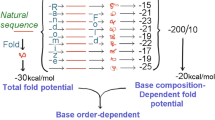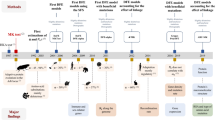Summary
Rates of substitution mutations in two directions, v [from an A-T or T-A nucleotide pair (AT-pair) to a G-C or C-G nucleotide pair (GC-pair)] and u [from a GC-pair to an AT-pair], are usually not the same. The net effect, v/(u + v), has previously been defined as directional mutation pressure (μ d ), which explains the wide interspecific variation and narrow intragenomic heterogeneity of DNA G+C content in bacteria. In this article, first, a theory of the evolution of DNA G+C content is presented that is based on the equilibrium among three components: directional mutation pressure, DNA G+C content, and selective constraints. According to this theory, consideration of both u and v as well as selective constraints is essential to explain the molecular evolution of the DNA base composition and sequence. Second, the theory of directional mutation pressure is applied to the analysis of the wide intragenomic heterogeneity of DNA G+C content in multicellular eukaryotes. The theory explains the extensive intragenomic heterogeneity of G+C content of higher eukaryotes primarily as the result of the intragenomic differences of directional mutation pressure and selective constraints rather than the result of positive selections for functional advantages of the DNA G+C content itself.
Similar content being viewed by others
References
Andachi Y, Yamao F, Muto A, Osawa S (1989) Codon recognition patterns as deduced from sequences of the complete set of transfer RNA species in Mycoplasma capricolum: resemblance to mitochondria. J Mol Biol 209:37–54
Belozersky AN, Spirin AS (1958) A correlation between the compositions of deoxyribonucleic and ribonucleic acids. Nature 182:111–112
Bernardi G, Olfsson B, Filipski J, Zerial M, Salinas J, Cuny G, Meunier-Rotival M, Rodier F (1985) The mosaic genome of the vertebrates. Science 228:953–958
Brahim A, D'Onofrio G, Mouchiroud D, Gardiner K, Gautier C, Bernardi G (1991) The compositional properties of human genes. J Mol Evol 32:493–503
Braun G, Cole ST (1984) DNA sequence analysis of the Serratia marcescens ompA gene: implications for the organization of an enterobacterial outer membrane protein. Mol Gen Genet 195:321–328
Chen GT, Inouye M (1990) Suppression of the negative effect of minor arginine codons on gene expression; preferential usage of minor codons within the first 25 codons of the Escherichia coli genes. Nucleic Acids Res 18:1465–1473
Cox EC, Yanofsky C (1967) Altered base ratios in the DNA of an Escherichia coli mutator strain. Proc Natl Acad Sci USA 58:1895–1902
Crow JF (1958) Some possibilities for measuring selection intensities in man. Hum Biol 30:1–13
D'Onofrio G, Mouchiroud D, Aissani B, Gautier C, Bernardi G (1991) Correlations between the compositional properties of human genes, codon usage and amino acid composition of proteins. J Mol Evol 32:504–510
Filipski J (1987) Correlation between molecular clock ticking, codon usage, fidelity of DNA repair, chromosome banding and chromatin compactness in the germline cells. FEBS Lett 217:184–186
Filipski J (1990) Evolution of DNA sequence: contributions of mutational bias and selection to the origin of chromosomal compartments. Adv Mutagen Res 2:1–54
Freese E (1962) On the evolution of base composition of DNA. J Theor Biol 3:82–101
Gasser SM, Laemmli UK (1987) A glimpse at chromosomal order. Trends Genet 3:16–22
Grantham R, Gauter C, Gouy M, Jacobzone M, Mercier R (1981) Codon catalog usage is a genome strategy modulated for gene expressivity. Nucleic Acids Res 9:r43-r74
Graur D (1985) Amino acid composition and the evolutionary rates of protein-coding genes. J Mol Evol 22:53–62
Grunstein M, Schedl P, Kedes L (1976) Sequence analysis and evolution of sea urchin (Lytechinus pictus and Strongylocentrotus purpuratus) histone H4 messenger RNAs. J Mol Biol 104:351–369
Haldane JBS (1937) The effect of variation on fitness. Am Nat 71:337–349
Hayashida H, Toh H, Kikuno R, Miyata T (1985) Evolution of influenza virus genes. Mol Biol Evol 2:289–303
Hoekema A, Kastelein RA, Vasser M, de Boer HA (1987) Codon replacement in the PGKI gene of Saccharomyces cerevisiae: experimental approach to study the role of biased codon usage in gene expression. Mol Cell Biol 7:2914–2924
Ikemura T (1985) Codon usage and t-RNA content in unicellular and multicellular organisms. Mol Biol Evol 2:13–34
Ikemura T, Ozeki H (1982) Codon usage and transfer RNA contents: organism-specific codon-choice patterns in reference to the isoacceptor contents. Cold Spring Harbor Symp Quant Biol 42:1087–1097
Jukes TH (1965) Genetic code, II. Am Sci 53:477–487
Jukes TH, Bhushan V (1986) Silent nucleotide substitutions and G+C content of some mitochondrial and bacterial genes. J Mol Evol 24:39–44
Kafatos FC, Efstratiadis A, Forget BG, Weissman SM (1977) Molecular evolution of human and rabbit β-globin mRNAs. Proc Natl Acad Sci USA 74:5618–5622
Kimura M (1968) Evolutionary rate at the molecular level. Nature 217:624–626
Kimura M (1977) Preponderance of synonymous changes as evidence for the neutral theory of molecular evolution. Nature 267:275–276
Kimura M (1983) The neutral theory of molecular evolution. Cambridge University Press, Cambridge
King JL, Jukes TH (1969) Non-Darwinian evolution. Science 164:788–798
Lee KY, Wahl R, Barbu E (1956) Contenu en bases puriques et pyrimidiques des acids desoxyribonucleiques des batteries. Ann Inst Pasteur 91:212–224
Li W-H, Wu C-I, Luo C-C (1985) Anew method for estimating synonymous and nonsynonymous rates of nucleotide substitution considering the relative likelihood of nucleotide and codon changes. Mol Biol Evol 2:150–174
Miyata T, Yasunaga T, Nishida T (1980) Nucleotide sequence divergence and functional constraint in mRNA evolution. Proc Natl Acad Sci USA 77:7328–7332
Mouchiroud D, Grautier C, Bernardi G (1988) The compositional distribution of coding sequences and DNA molecules in humans and murids. J Mol Evol 27:311–320
Muller HJ (1950) Our load of mutations. Am J Hum Genet 2:111–176
Muto A, Osawa S (1987) The guanine and cytosine content of genomic DNA and bacterial evolution. Proc Natl Acad Sci USA 84:166–169
Nakamura K, Pirtle RM, Pirtle IL, Taseishi K, Inouye M (1980) Messenger ribonucleic acid of the lipoprotein of the Escherichia coli outer membrane. J Biol Chem 255:210–216
Nomura M, Sor F, Yamagishi M, Lawson M (1987) Heterogeneity of GC content within a single bacterial genome and its implication for evolution. Cold Spring Harbor Symp Quant Biol 52:658–663
Ohama T, Muto M, Osawa S (1990) Role of GC-biased mutation pressure on synonymous codon choice in Micrococus luteus, a bacterium with a high genomic GC-content. Nucleic Acids Res 18:1565–1569
Ohno S (1988) Universal rule for coding sequence construction: TA/CG deficiency TG/CT excess. Proc Natl Acad Sci USA 85:9630–9634
Osawa S, Ohama T, Yamao F, Muto A, Jukes TH, Ozeki H, Umesono K (1988) Directional mutation pressure and transfer RNA in choice of the third nucleotide of synonymous two codon sets. Proc Natl Acad Sci USA 85:1124–1128
Post LE, Stycharz GD, Nomura M, Lewis H, Dennis PP (1979) Nucleotide sequence of the ribosomal protein gene cluster adjacent to the gene for RNA polymerase subunit β in Escherichia coli. Proc Natl Acad Sci USA 76:1697–1701
Rolfe R, Meselson M (1959) The relative homogeneity of microbial DNA. Proc Natl Acad Sci USA 45:1039–1043
Sharp PM, Li WH (1989) On the rate of DNA sequence evolution in Drosophila. J Mol Evol 28:398–402
Sueoka N (1959) A statistical analysis of deoxyribonucleic acid distribution in density gradient centrifugation. Proc Natl Acad Sci USA 45:1480–1490
Sueoka N (1961) Compositional correlation between deoxyribonucleic acid and protein. Cold Spring Harbor Symp Quant Biol 26:35–43
Sueoka N (1962) On the genetic basis of variation and hetero-geneity of DNA base composition. Proc Natl Acad Sci USA 48:582–592
Sueoka N (1988) Directional mutation pressure and neutral molecular evolution. Proc Natl Acad Sci USA 85:2653–2657
Sueoka N, Marmur J, Doty P (1959) Heterogeneity in deoxyribonucleic acids. II. Dependence of the density of deoxyribonucleic acids on guanine-cytosine. Nature 183:1427–1431
Wada A, Suyama A (1986) Local stability of DNA and RNA secondary structure and its relation to biological functions. Prog Biophys Mol Biol 47:113–157
Wada K, Aota S, Tsuchiya R, Ishibashi F, Gojobori T, Ikemura T (1990) Codon usage tabulated from the GenBank genetic sequence data. Nucleic Acids Res [Suppl] 18:2367–2411
Wright S (1938) The distribution of gene frequencies under irreversible mutation. Proc Natl Acad Sci USA 24:253–259
Yomo T, Ohno S (1989) Concordant evolution of coding and noncoding regions of DNA made possible by the universal rule of TA/CG deficiency-TG/CT excess. Proc Natl Acad Sci USA 86:8452–8456
Author information
Authors and Affiliations
Rights and permissions
About this article
Cite this article
Sueoka, N. Directional mutation pressure, selective constraints, and genetic equilibria. J Mol Evol 34, 95–114 (1992). https://doi.org/10.1007/BF00182387
Received:
Revised:
Issue Date:
DOI: https://doi.org/10.1007/BF00182387




